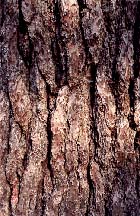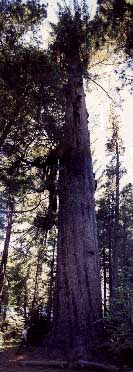
Cones and needle fascicles [Dr. Linda B. Brubaker].

Bark on a tree in Calaveras Big Trees State Park, California [C.J. Earle].
Common Names
Sugar pine, big or great sugar pine (2), pino de azucar, ocote (3).Taxonomic notes
Description
Trees to 30-50(75) m tall and 90-180(330) cm in diameter, massive (the largest species in the genus), straight. Crown narrowly conic, becoming rounded or flat-topped. Bark cinnamon- to gray-brown, deeply furrowed, plates long, scaly. Branches long, nearly horizontal, bearing cones near the ends, distal branches ascending; twigs gray-green to red-tan, aging gray, mostly puberulent. Buds cylindro-ovoid, red-brown, to 8 mm, resinous. Leaves 5 per fascicle, spreading to ascending, persisting 2-4 years, 5-10 cm × 1-1.5(2) mm, sharp, straight, slightly twisted, pliant, blue-green, abaxial surface with only a few lines evident, adaxial surfaces with evident white stomatal lines, margins finely serrulate, apex acuminate; sheath (1)1.5-2 cm, shed early. Staminate cones ellipsoid-cylindric, to 15 mm, yellow. Ovulate cones maturing in 2 years, shedding seeds and falling soon thereafter, often clustered, pendent, symmetric, cylindric before opening, lance-cylindric to ellipsoid-cylindric when open, 25-50 cm (the longest of any conifer), shiny yellow-brown, stalks 6-15 cm; apophyses somewhat thickened; umbo terminal, depressed, resinous, slightly excurved. Seeds obovoid, oblique apically; body 1-2 cm, deep brown; wing broad, 2-3 cm. 2 n =24 (4, 5).It is easily distinguished from P. monticola by its larger cones and thicker cone scales with larger seeds; it is somewhat less reliably distinguished by its leaves, which are slightly wider and more tapering-tipped and have some stomatal lines evident on the abaxial surfaces (the lines not evident in P. monticola ) (5).
Range
From about 45° latitude in US: Oregon S (including W Nevada) to S California and Mex: Baja California Norte, S in the Sierra San Pedro Mártir, at 300-3200 m depending on latitude etc. Occurs on various soils, usually in mountains, usually in mixed conifer forests (4). See also (12).Big Tree
Height 66.1 m, dbh 352 cm, crown spread 9 m, visible from the general store in Dorrington, CA (8). Also height 81.7 m, dbh 281 cm, at Hogden Meadow in Yosemite National Park, CA (10).David Douglas, who first described this tree, writes in October 1826 that "I shall here state the dimensions of the largest I could find among several that had been blown down by the wind. At 3 feet from the ground its circumference is 57 feet 9 inches [560 cm diameter]... the extreme length 245 feet" [75 m] (quoted in (6)).
Oldest
Muir (6) says 800 years but provides no more information. There is another record of 760 years, also without supporting details (11). I have seen it growing on extremely poor and virtually fireproof sites (basically no soil, just fractured granite bedrock) in the Sierra San Pedro Martír of Baja California Norte, and this would be a fine place to seek exceptionally old individuals.Dendrochronology
Holmes et al. (9) collected a chronology in the California Coast Range. There are also two published fire history studies.Ethnobotany
A "sugary" resin high in cyclitols exudes from the sweet-scented fresh-cut wood (5). Muir (6) reports: "The sugar, from which the common name is derived, is to my taste the best of sweetsóbetter than maple sugar. It exudes from the heartwood, where wounds have been made, either by forest fires, or the ax, in the shape of irregular, crisp, candy-like kernels, which are crowded together in masses of considerable size, like clusters of resin-beads... Indians are fond of it, but on account of its laxative properties only small quantities may be eaten."Logging practices of the early 20th century, at which time most of the big stands of old-growth sugar pine were logged, are described by Muir (6), who notes that it was a sought-after species for shingles as well as lumber. It is currently valued timber tree due to its high dimensional stability, workability, and potentially rapid growth rate (7). However, harvest of sugar pine far exceeds regrowth (5).
Observations
Seen at many locations in CA and OR. Historically, the species reached its best development in the northern Sierra Nevada, in the area centered on Calaveras Big Trees State Park. This area was logged extensively in the late 1800s and early 1900s but still contains the largest individual trees. The forests of Yosemite, south of Yosemite Valley, are also a showcase for this species. See (6) for an outstanding description of these Sierran forests. It grows as a krummholz tree a few feet below the 3100 m summit of Picacho del Diablo in the Sierra San Pedro Mártir, and as a grand forest tree lower in the range. See the Observations section of P. jeffreyi for more on these forests.Remarks
White pine blister rust ( Cronartium ribicola ), an introduced fungal disease, has decimated formerly extensive stands of this and certain other white pines (4).Pinus lambertiana is singularly resistant to hybridization (no natural hybrids are known), but fertile crosses with the Chinese pine Pinus armandii have been found to have high resistance to blister rust (7).
Citations
(2) Peattie 1950 .(3) Perry 1991 .
(4) Little 1980 .
(5) Robert Kral in the Flora of North America online .
(6) Muir 1894 .
(7) Burns & Honkala 1990 .
(8) E-mail communication from Robert Van Pelt, who measured this tree; 18-Mar-1998.
(9) Holmes et al. 1986 .
(10) E-mail communication from Robert Van Pelt, who measured this tree; 22-Jul-1999.
(11) Carder 1995 .
(12) Robert S. Thompson, Katherine H. Anderson and Patrick J. Bartlein. 1999. Atlas of Relations Between Climatic Parameters and Distributions of Important Trees and Shrubs in North America. U.S. Geological Survey Professional Paper 1650 A&B. URL= http://greenwood.cr.usgs.gov/pub/ppapers/p1650-a/pages/conifers.html , accessed 22-Jan-2000.
See also:
Arno & Gyer 1973
.
Farjon & Styles 1997
.
Lanner 1983
.
FEIS database
.
Silba 1986
.
The Ecological Role of Fire in Sierran Conifer Forests
.
back | Pinus | Pinaceae | home
This page is from the Gymnosperm Database
URL: http://www.geocities.com/~earlecj/pi/pin/lambertiana.htm
Edited by Christopher J. Earle
E-mail:
earlecj@earthlink.com
Last modified on 28-Jan-2000
